Saturn 2021
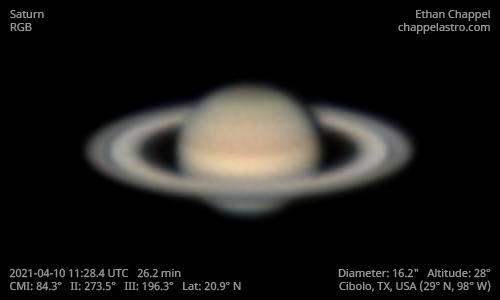
UTC
Although Saturn has been visible in the morning sky for a while now, the wait for clear weather has finally ended. It was very windy and the air above was very turbulent. This was my first time having insulation wrapped around the OTA while imaging a planet. Despite having just bringing the scope out to a cooler environment, I saw no internal heat plume while collimating the secondary mirror.
This was also the first time I used my Chroma extended green filter on Saturn. As expected, the new filter gave a brighter image compared to the standard green. The 11:28 image uses the standard green filter while the 11:29 image uses the extended green. I am hoping for better conditions soon so I can create a solid comparison between both filters.
As Saturn's axial tilt continues to decrease, more of the southern hemisphere is revealed. The planet is now at about the same tilt as it was when I first imaged it in 2013.
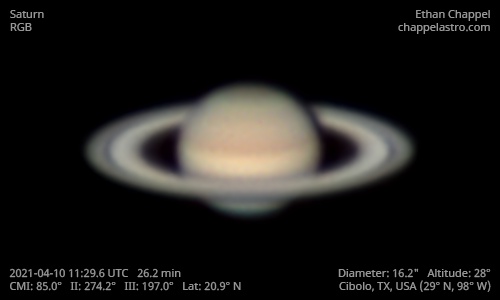
UTC
Although Saturn has been visible in the morning sky for a while now, the wait for clear weather has finally ended. It was very windy and the air above was very turbulent. This was my first time having insulation wrapped around the OTA while imaging a planet. Despite having just bringing the scope out to a cooler environment, I saw no internal heat plume while collimating the secondary mirror.
This was also the first time I used my Chroma extended green filter on Saturn. As expected, the new filter gave a brighter image compared to the standard green. The 11:28 image uses the standard green filter while the 11:29 image uses the extended green. I am hoping for better conditions soon so I can create a solid comparison between both filters.
As Saturn's axial tilt continues to decrease, more of the southern hemisphere is revealed. The planet is now at about the same tilt as it was when I first imaged it in 2013.
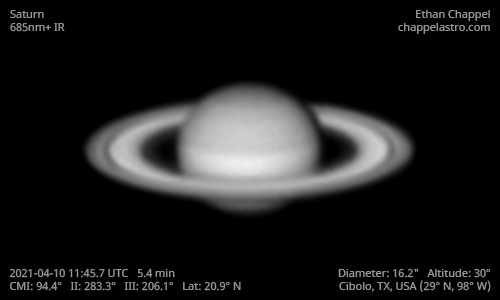
UTC
Although Saturn has been visible in the morning sky for a while now, the wait for clear weather has finally ended. It was very windy and the air above was very turbulent. This was my first time having insulation wrapped around the OTA while imaging a planet. Despite having just bringing the scope out to a cooler environment, I saw no internal heat plume while collimating the secondary mirror.
This was also the first time I used my Chroma extended green filter on Saturn. As expected, the new filter gave a brighter image compared to the standard green. The 11:28 image uses the standard green filter while the 11:29 image uses the extended green. I am hoping for better conditions soon so I can create a solid comparison between both filters.
As Saturn's axial tilt continues to decrease, more of the southern hemisphere is revealed. The planet is now at about the same tilt as it was when I first imaged it in 2013.
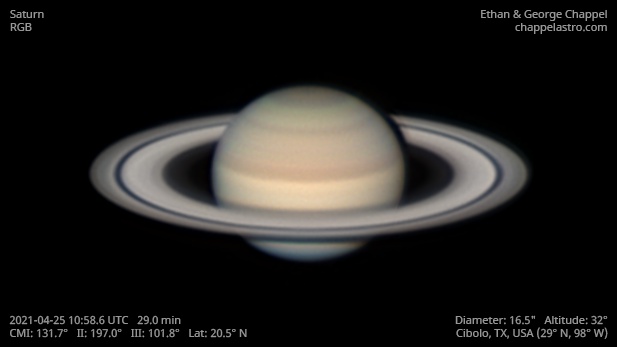
UTC
Sky conditions were significantly better than two weeks ago. Saturn is now reaching 30 degrees high while it is dark enough to image. It will transit 42 degrees from my location, just a few degrees higher than last apparition.
The southern hemisphere has a blue hue while the north has a green tint near the pole.

UTC
Good seeing conditions, but clouds rolled in just as I started recording. This was the first night with my new Sky-Watcher EQ6-R Pro. While my primary use for this mount will be for deep sky imaging, it will also let me use the EdgeHD 11 in times I would have used the EdgeHD 8 for planetary imaging.
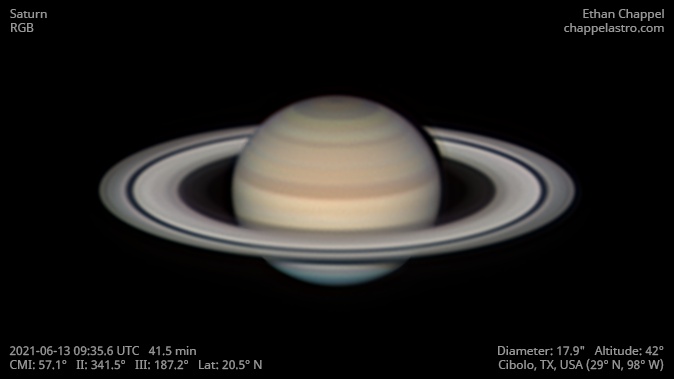
UTC
Excellent seeing conditions. This is a second attempt with my EdgeHD 11 and new Sky-Watcher EQ6-R Pro after a near-failure yesterday because of clouds. My primary use for this mount will be for deep sky imaging, but I can also use it for planetary imaging with the EdgeHD 11 in times I would've used the EdgeHD 8 and Advanced VX.
Notes:
- The North Polar Hexagon has a reddish color with little contrast.
- Some banding is becoming visible in the southern hemisphere as the rings slowly uncover it from Earth's perspective.
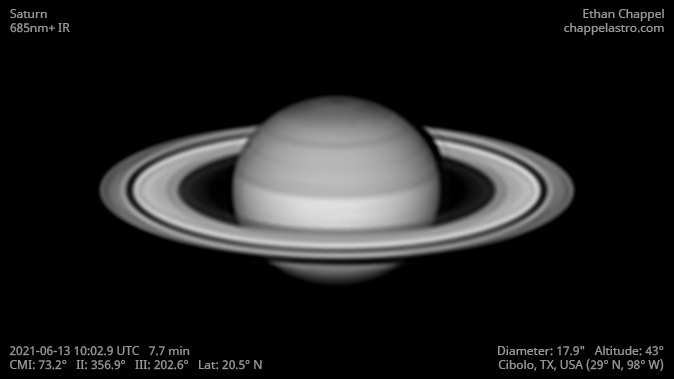
UTC
Excellent seeing conditions. This is a second attempt with my EdgeHD 11 and new Sky-Watcher EQ6-R Pro after a near-failure yesterday because of clouds. My primary use for this mount will be for deep sky imaging, but I can also use it for planetary imaging with the EdgeHD 11 in times I would've used the EdgeHD 8 and Advanced VX.
Notes:
- The perimeter of the North Polar Hexagon is bright in near-infrared, making it stand out more than in visible light.
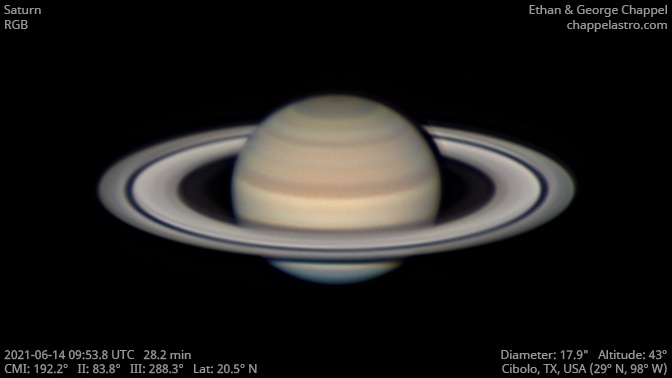
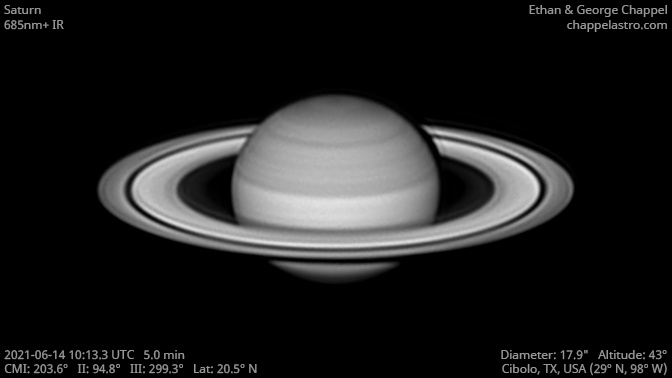

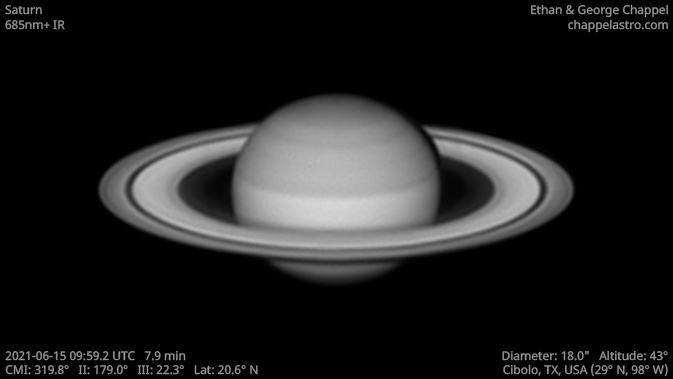
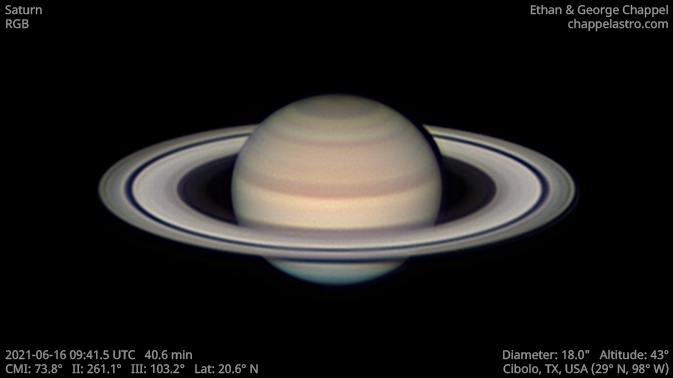
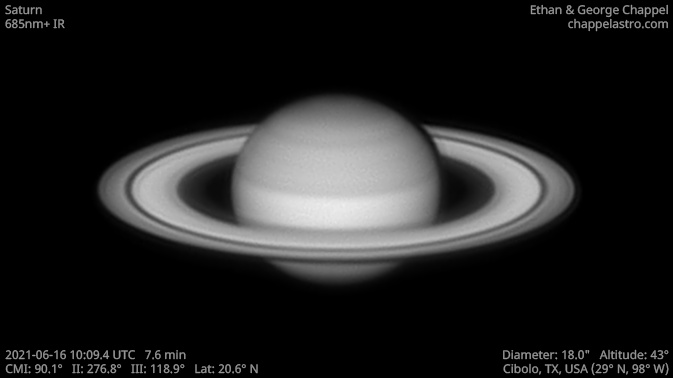
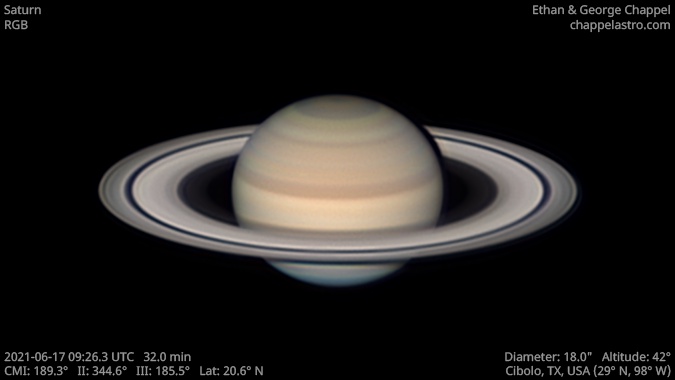
UTC
Very good night of seeing with lots of bands visible on the planet. The North Polar Hexagon has a red tinge and little contrast. The southern hemisphere is blue after years of sunlight being blocked by the rings. No storm activity is visible on the planet.
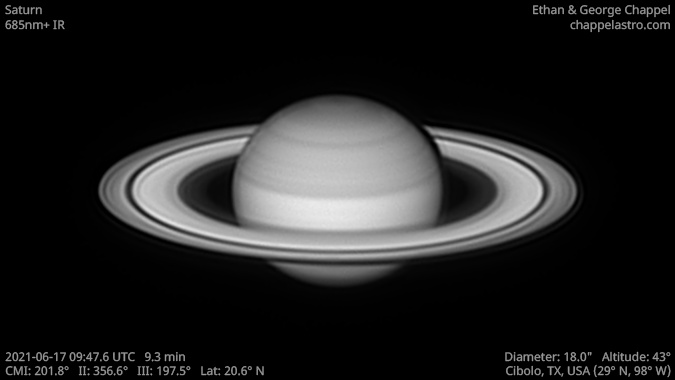
UTC
Very good night of seeing with lots of bands visible on the planet. The North Polar Hexagon has a red tinge and little contrast. The southern hemisphere is blue after years of sunlight being blocked by the rings. No storm activity is visible on the planet.

UTC
Very good night of seeing with lots of bands visible on the planet. The North Polar Hexagon has a red tinge and little contrast. The southern hemisphere is blue after years of sunlight being blocked by the rings. No storm activity is visible on the planet.
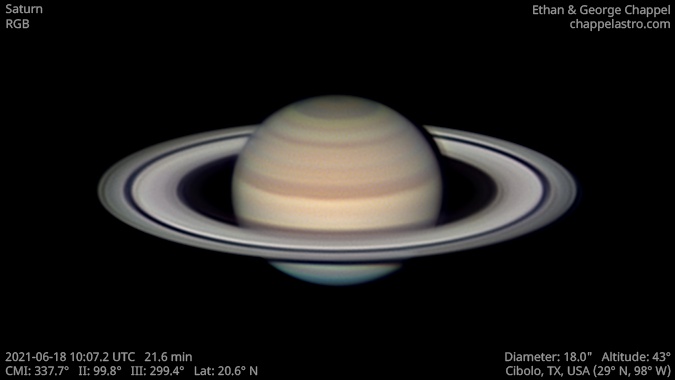
UTC
Good seeing on June 18th. The southern hemisphere appears to have a red stripe through its otherwise blue color. The north polar hexagon has little contrast.
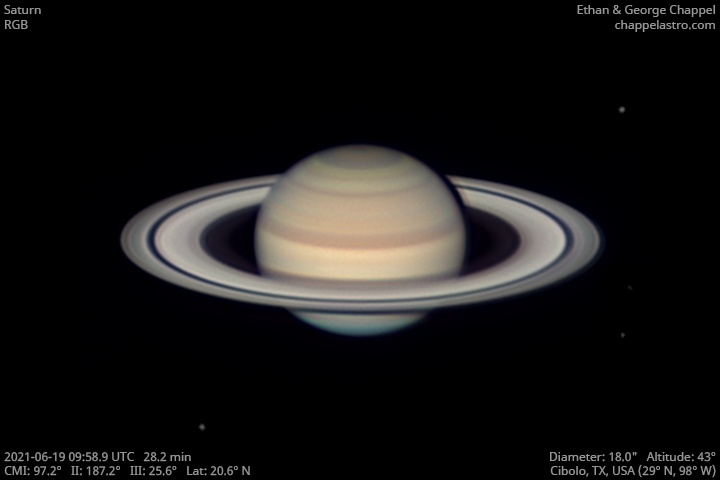
UTC
Good seeing on June 19th, 2021. I took the time to capture some of the closer moons using longer exposures between RGB runs. Visible counterclockwise from bottom-left to top-right are Dione, Enceladus, Mimas, and Tethys.

UTC
An unexpected yet excellent night of planetary imaging. This night is probably about as good as I can get with the EdgeHD 11.
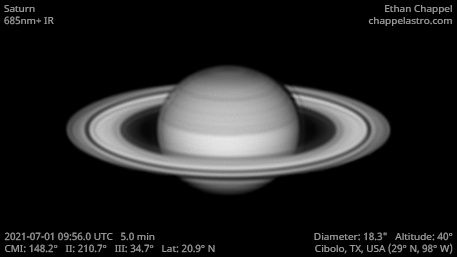
UTC
An unexpected yet excellent night of planetary imaging. This night is probably about as good as I can get with the EdgeHD 11.
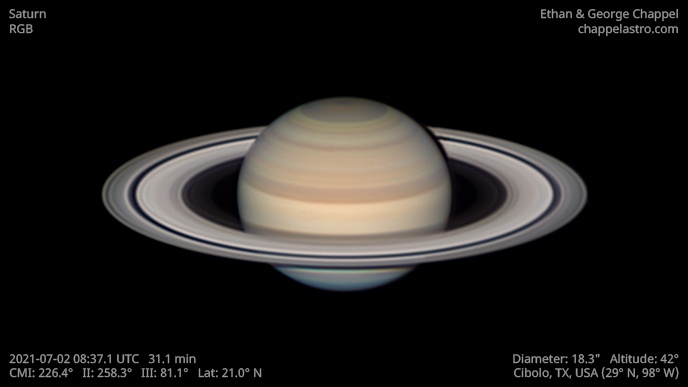
UTC
A beautiful night with excellent seeing July 2, 2021. We were prepared this time and took out the EdgeHD 14 to take high resolution images of Saturn.
Many bands are visible across the planet. Despite the high resolution of this image, the north polar hexagon is hard to distinguish other than a slight reddish tinge. In contrast to the yellow-brown and green dominating the northern hemisphere, the southern hemisphere has various shades of blue. When a hemisphere tilts away from the Sun, the rings block most of the sunlight from reaching it. The lack of sunlight causes the ammonia clouds that define Saturn's color to clear out and expose the Hydrogen gas deeper in the atmosphere.
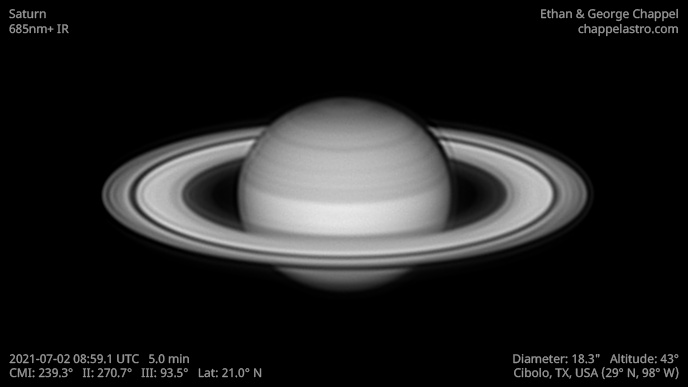
UTC
A beautiful night with excellent seeing July 2, 2021. We were prepared this time and took out the EdgeHD 14 to take high resolution images of Saturn.
Many bands are visible across the planet. Despite the high resolution of this image, the north polar hexagon is hard to distinguish other than a slight reddish tinge. In contrast to the yellow-brown and green dominating the northern hemisphere, the southern hemisphere has various shades of blue. When a hemisphere tilts away from the Sun, the rings block most of the sunlight from reaching it. The lack of sunlight causes the ammonia clouds that define Saturn's color to clear out and expose the Hydrogen gas deeper in the atmosphere.
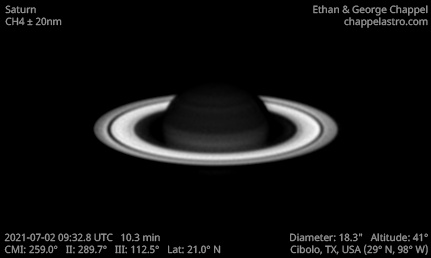
UTC
A beautiful night with excellent seeing July 2, 2021. We were prepared this time and took out the EdgeHD 14 to take high resolution images of Saturn.
Many bands are visible across the planet. Despite the high resolution of this image, the north polar hexagon is hard to distinguish other than a slight reddish tinge. In contrast to the yellow-brown and green dominating the northern hemisphere, the southern hemisphere has various shades of blue. When a hemisphere tilts away from the Sun, the rings block most of the sunlight from reaching it. The lack of sunlight causes the ammonia clouds that define Saturn's color to clear out and expose the Hydrogen gas deeper in the atmosphere.